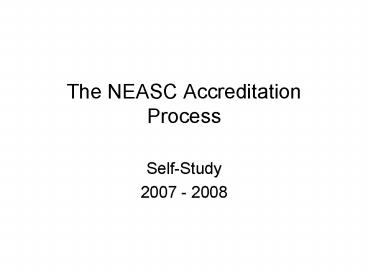The NEASC Accreditation Process PowerPoint PPT Presentation
1 / 17
Title: The NEASC Accreditation Process
1
The NEASC AccreditationProcess
- Self-Study
- 2007 - 2008
2
What Does Accreditation Mean?
- Adherence to Standards established by member
schools regarding the systems, processes, and
practices of school personnel - Demonstration of school improvement based on
steps taken to address evaluation report findings - Adherence to Commission procedures and policies
3
Major Phases of the Accreditation Cycle
- Self-Study Phase (1 year) 2007 - 2008
- An in-depth, reflective examination of the
schools educational programs and services based
on the Standards - Hosting a Visit (4 days) Projected Fall - 2008
- A visiting committee of peers will meet with
representatives from all school constituencies
and write an evaluation report - Follow-Up Phase (5 years)
- The action phase of the process during which time
the school is responsible for implementing the
evaluation report
4
The Accreditation Ten Year Cycle
5
How Will the NEASC Process Improve Student
Learning?
- Assists administrators and teachers in working
toward school improvement - Assures students that their needs are being met
through a quality educational program - Affirms that school board educational policies
are sound - Assures the local citizen that tax dollars are
supporting quality school programs and quality
facility
6
How Will the NEASC Process Improve Student
Learning?
- Improved instruction
- Improved organizational effectiveness and
long-term planning - Enables schools to identify strengths and
weaknesses - Fosters teamwork and collegiality
- Improves professional development
- Improves school resources
- Provides effective system for ensuring school
accountability - Offers teachers buy in to use the report findings
as a tool for continued school improvement
7
How Will the NEASC Process Improve Student
Learning?
- Provides exposure to new learning trends and
innovations - Increased parental and community support for
school initiatives and involvement - Increased continuity and consistency in best
practices - Leads to better staffing decisions
- Provides exposure to peer evaluators
8
Emphasis on Standards
- Accountability for essential learning for all
students - A reflective school culture
- Professional development tied to teaching and
learning needs based on best practice - Strong instructional leadership and resources
- Personalization
- Formative Assessment
- Equity Failure is not an Option
9
Overreaching Concepts of NEASC
10
Long Term Accreditation Goals
- Engage the professional staff in using the
Standards to impact teaching and learning - Use the accreditation process as a foundation to
effect changes/initiatives to benefit students,
professional staff, parents and community - Infuse the Mission and Expectations into the
daily life of the school - Use the Mission and Expectations to guide
decision making processes
11
The Essential Question
- To what extent does our school adhere to each of
the indicators in each Standard?
12
Required Tasks to Complete Self-Study
- All faculty are organized into 7 committee
teams, representing a team for each standard - Each committee is responsible for gathering
evidence, conducting surveys and questionnaires,
analyzing current practices and writing
reflective essays in response to specific
questions. - Each team must collect and organize artifacts for
the site visit.
13
06-07 Timeline to Address EWHSFocus on Teaching
and Learning
- Goal
- To evaluate the structure of how we organize and
deliver instruction to produce the graduate we
envision.
- Activities
- Fall 06 - High School Reform Framework shared
with ATM, HS Leadership, HS Staff - Fall/Winter 06-07 - Development of HS Scheduling
Committee - Ongoing Meetings
- Staff Survey
- Research Best Practices
- Visitation to South Windsor
- Collaboration with Union
14
Next Steps
- July 07
- Run Mock Schedules on Rediker
- Analyze Strengths and Challenges of Each Mock
Schedule - Fall 07
- Discuss with Union, Faculty and all
Administration - Present Findings and Recommendations to BOE
- Pilot/Implement Recommendations in 08-09
15
Proposed One Year Alternative Schedule
- Monthly Two Hour Delayed Opening
- Second Thursday of Each Month
- September 6
- October 11
- November 8
- December 13
- January 10
- February 14
- March 13
- April 10
- May 8
- June 5 (1st Thursday)
- Two Hour Delayed Rotation Schedule
- A 930 1007
- B C Periods Eliminated
- D 1011 1057
- E 1101 1225
- F 1229 115
- G - 1 19 205
16
Scheduling Advantages
- Instructional time remains within DRG and state
average - Product of the time spent by teachers will result
in an increase of rigor in instruction for our
students - Research supports a later opening for teens
- Union Support
- Change does not impact contract
- Older siblings will be home with younger siblings
to help with AM bussing - Adequate time to accomplish NEASC requirements
17
Scheduling Disadvantages
- Decrease of a maximum of 20 hours of
instructional time - Possible parental inconvenience
- Scheduling of Busses

